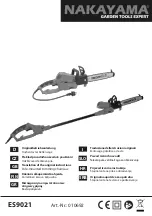
3.18
As mentioned, beside each input and output terminal there is a bank of red LED’s. Each light corresponds to an input or
output. An input LED will light when it’s specific input signal is being received at the PLC and output LED’s will light when the
PLC commands specific outputs. If an output LED is present but the output does not happen, then either the output relay is
faulty/stuck or the output (3 amp) fuse is blown. If a fuse is blown, a shorted directional valve coil, shorted noise suppressor
at the coil or shorted wiring could be the cause (a good coil will measure between 30 to 40 ohms). If the fuse is good and no
output voltage condition still exists, with the output light on, then the relay is defective. If this is the case the PLC will have
to be returned to the manufacturer for repair.
FUSES
The PLC outputs are protected with four glass fuses which are mounted on TB1(Beside PLC).
Fuse “FU8” is a 2 amp instant blow fuse which feeds power to the input side of the PLC thorough input terminal “L”
Fuses “FU3” and “FU5” to “FU7” are 3 amp time delay fuses which each supply power to a specific bank of output relays
through that bank of relays “COM” terminal:
FU3 is wired to terminal “COM1” supplying outputs -Y0, Y1, Y2, Y3
FU5 is wired to terminal “COM3” supplying outputs -Y10, Y11, Y12, Y13
FU6 is wired to terminal “COM4: supplying outputs -Y14, Y15, Y16, Y17
FU7 is wired to terminal “COM5” supplying outputs -Y20, Y21, Y22, Y23
Problem 4
No Display
Possible Causes:
1. No power to the PLC
2. PLC unit failure
3. Faulty connection of cable between PLC and Interface
Diagnosis:
a. Check the power led. This light should be on when the PLC is switched on.
b. If the light is on, the PLC may have failed. Check for proper connection of the cable at the PLC and at the
interface. Also check the PLC fuse.
c. If the fuse is OK, ensure that power is being supplied to the fuse.
Problem 5
No blade speed display
Possible Causes:
1.
Fault at the proximity sensor
a. Bad sensor, mis-adjusted sensor (the gap should be approx .030” - .040”)
b. Contamination on the end of the sensor.
2.
Fault at the PLC
a. Bad connection of sensor wiring
b. Faulty PLC unit.
Diagnosis:
•
Check for the LED light on the sensor. The light indicates that the sensor has power and is activated. The problem
could be with the sensor, signal wire to the PLC or with the PLC itself. With the blade running, the light on the
back of the sensor should “pulse”. Likewise, the PLC input LED X2, should also be “Pulsing”. If both LED’s are
pulsing with the blade running, the PLC is the problem. If the sensor is pulsing but the input LED on the
PLC is not, there is a problem between the sensor and the PLC unit.
•
If the LED on the sensor is not on, the problem is with the sensor wiring or the sensor is at fault.
Summary of Contents for H28A-120
Page 2: ......
Page 12: ...0 8 Item 391335 Item 391938 ...
Page 13: ...0 9 Item 391937 Idler Guide Arm Drive Guide Arm Item 391340 ...
Page 14: ...0 10 Fixed Vise Shuttle Vise Item 392801 ...
Page 72: ...4 1 ELECTRICAL SCHEMATICS SEE PDF ON ATTACHED CD SECTION 4 ELECTRICAL ...
Page 73: ...5 1 SECTION 5 HYDRAULIC HYDRAULIC SCHEMATICS PLUMBING DIAGRAMS SEE PDF ON ATTACHED CD ...
Page 75: ...7 1 SECTION 7 OPTIONS OPTIONAL ASSEMBLY DRAWINGS SEE PDF ON ATTACHED CD ...
Page 88: ...9 2 ...
















































